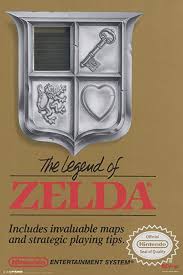The Legend of Zelda – Nintendo Entertainment System Review
3 min read
The Legend of Zelda for the Nintendo Entertainment System, published by Nintendo and released in Japan on February, 21 1986, was a game with innovation that has never stopped echoing across the industry. We fell hopelessly in love with the story of a hero uniting the eight fragments of the Triforce of Wisdom to save Princess Zelda from the clutches of the evil Gannon, the Prince of Darkness. The cartridge comes with an instruction manual (46 pages), which is basically a little story book that includes helpful information about items Link will collect, enemies he will face, and what to expect in the 8-bit world of Hyrule. The hero starts out weaponless, but as the guide indicates there are merchants living in caves that are willing to help. Our first task, when the screen splits and slides open, is to go and collect the free wooden sword from the old man in the nearby cave. Let the adventure begin.
Now what? That’s the glory of The Legend of Zelda. The entire world of Hyrule is open and the player is encouraged to explore. Link will need a wallet full of rupees, so slaying those reoccurring minions of darkness, such as Tektites, Octoroks, and Leevers, is essential. The player may want to purchase the Magic Shield, a candle, Enemy Bait, or a blue ring that will increase Link’s defense. It is possible to complete the game without the help of some items, or even skipping a few of the treasures in the labyrinth, but that is not recommended unless the player seeks a challenge. Adventuring and enduring to acquire all of the hearts and items may seem daunting, but just like grinding for that next level the time spent is well worth the reward.
Link always holds his sword in the A button slot. Pressing the Select key brings down an item screen for the player to select an item for the B button slot, such as the Boomerang or the Magic Wand. On the same screen, the player can also see how many pieces of the Triforce they have collected and the other treasures that do not need to be assigned to the B button for use. The map appears on either screen. The overworld map is my biggest complaint. There is no detail that fills it in as the player explores. It remains a grey rectangle with a moving square for the duration of the entire game, no matter how much progression is made.
The Official Nintendo Player’s Guide was published in 1987, which offered a little more information than the manual. The NES Game Atlas, Nintendo’s Player Guide, published in 1991, provided tremendous detail, including the locations of merchant’s caves and hidden secrets in the overworld, as well as fairies and heart containers. The reason I mention this guide is largely due to the difficulty presented in Death Mountain, Level 9, the lair of Gannon. This labyrinth has multiple warp points, twelve to be exact, which makes this dungeon incredibly more intimidating than the others. Not to mention the map is shaped like a skull. Each boss has a unique way of defeating it efficiently, a trait that has stuck with The Legend of Zelda series since its birth.
The Legend of Zelda for NES is a game that can be enjoyed time and time again. The adventure will be arduous, and then the player is tempted by the Second Quest, which changes the dungeons altogether and the locations of many items. Before long, players will find themselves seeking adventure like only The Legend of Zelda can bring them, and challenge themselves to do better on additional playthroughs. Although the story is not delivered during gameplay, reading what is provided in the manual offers motivation for Link’s dangerous quest.



